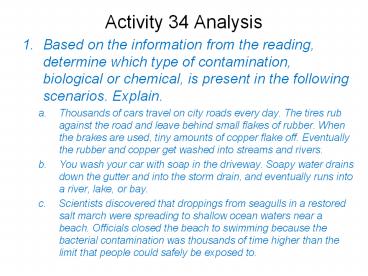Activity 34 Analysis - PowerPoint PPT Presentation
1 / 17
Title:
Activity 34 Analysis
Description:
Activity 34 Analysis Based on the information from the reading, determine which type of contamination, biological or chemical, is present in the following scenarios. – PowerPoint PPT presentation
Number of Views:24
Avg rating:3.0/5.0
Title: Activity 34 Analysis
1
Activity 34 Analysis
- Based on the information from the reading,
determine which type of contamination, biological
or chemical, is present in the following
scenarios. Explain. - Thousands of cars travel on city roads every day.
The tires rub against the road and leave behind
small flakes of rubber. When the brakes are used,
tiny amounts of copper flake off. Eventually the
rubber and copper get washed into streams and
rivers. - You wash your car with soap in the driveway.
Soapy water drains down the gutter and into the
storm drain, and eventually runs into a river,
lake, or bay. - Scientists discovered that droppings from
seagulls in a restored salt march were spreading
to shallow ocean waters near a beach. Officials
closed the beach to swimming because the
bacterial contamination was thousands of time
higher than the limit that people could safely be
exposed to.
2
- Scenarios (a) and (b) are chemical contamination
- Scenario (c) is biological contamination
- Explain how water contaminated from a mine could
end up in the ocean 100 miles away. - Make a list of things you do every day that
require clean and safe water. - Reflection Write about some things you and your
community regularly do that could threaten the
water supply.
3
Title Mystery Liquids
Activity 35
4
How would you describe the contents of these
containers?
- Clear
- Colorless
- Liquid
5
What is the difference between a solid, liquid,
and gas?
- Unlike solids, the liquid phase is free flowing
and takes on the shape of its container (as do
gases). - Like solids (but not gases), liquids hold
together and have a definite volume. Gases
expand to fill any container, and have neither a
definite shape nor a volume. - All substances are made of characteristic smaller
pieces or parts, such as atoms or molecules.
6
Comparing Solids, Liquids, and Gases
- The basic particles do not change - only the
arrangement and distance between particles change
during a phase change. - Phase changes are examples of physical changes.
7
Water Phase Changes
8
How would you find out what the two liquids are?
- Observe or test them more closely.
- Compare the results to known characteristics of
specific liquids. - Gather Data!
9
Read C-29
- Problem How can physical properties help you
identify substances? - Hypothesis/Initial Thoughts
10
Vocabulary Review
- What word do we have for data that is numerical?
- Measurement
- Quantitative data involves descriptions based on
measurements - What type of data describes characteristics
people can perceive without making measurements? - Qualitative data
11
Qualitative Data (Observations)
- Appearance
- Visually examine the vials
- Smell
- Wave the air above each liquid toward your nose
- Feel on Fingers
- Place one drop on your finger and rub with thumb
- Behavior of a Drop on Plastic
- Try to move the drop with a stir stick on plastic
- Evaporation
- Place a drop on the glass slide. Does it
evaporate? - Possible Identities
- Do you know what it is?
12
Quantitative Data (Measurements)
- Density
- Use a volume of 3.0 mL for groups 1 8
- 4.0 mL for groups 2 7
- 5.0 mL for groups 3 6
- 6.0 mL for groups 4 5
- Mass the empty cylinder and subtract that from
the cylinder with the liquid - Density mass/Volume
- Boiling Point
- Demonstration
- Melting Point
- Demonstration
13
Table 1 Observations of Two Unidentified Liquids
Property Liquid A Liquid B
Qualitative Data (observations) Qualitative Data (observations) Qualitative Data (observations)
Appearance
Smell
Feel on fingers
Behavior of a drop on plastic
Evaporation
Possible identities
Quantitative data (measurements) Quantitative data (measurements) Quantitative data (measurements)
Density
Boiling point
Melting point
Possible identities
97 103 ºC
75 81 ºC
-2 - 2 ºC
Not measured
Table 2 Density Calculations
Liquid A Liquid B
Volume of liquid sample
Mass of graduated cylinder
Mass of cylinder plus liquid
Mass of liquid sample
Density of liquid
14
Density
- Compare densities for Liquids A and B
- Does the amount of liquid change the density?
- When more liquid is added to the graduated
cylinder, what happens to the volume? - To the mass?
- If you pour some out, what happens?
- If you double the volume, what happens to the
mass?
15
1. Review the Data Table below
Some Properties of Five Liquids Some Properties of Five Liquids Some Properties of Five Liquids Some Properties of Five Liquids Some Properties of Five Liquids Some Properties of Five Liquids
Liquid Water Methanol Ethanol Isopropanol Acetone
Appearance Clear Clear Clear Clear Clear
Smell None Yes Yes Yes Yes
Shape of a drop on plastic Round Flat Flat Flat Flat
Density (g/mL) 1.000 0.791 0.789 0.786 0.790
Boiling Point (ºC) 100 65 78 82 56
Melting Point (ºC) 0 -94 -117 -90 Undefined
16
Analysis Questions 1 and 2
- Substances can be identified based on their
properties. - What was Liquid A?
- Water
- What was Liquid B?
- Ethanol
17
Phases of Water
Time Temp Description Time Temp Description
0 -20 Solid Ice 12 60 Liquid Water
2 0 Melting Ice 14 80 Liquid Water
4 0 Melting Ice 16 100 Boiling Water
6 0 Melting Ice 18 100 Boiling Water
8 20 Liquid Water 20 100 Water Vapor Gas
10 40 Liquid Water 22 120 Water Vapor Gas































